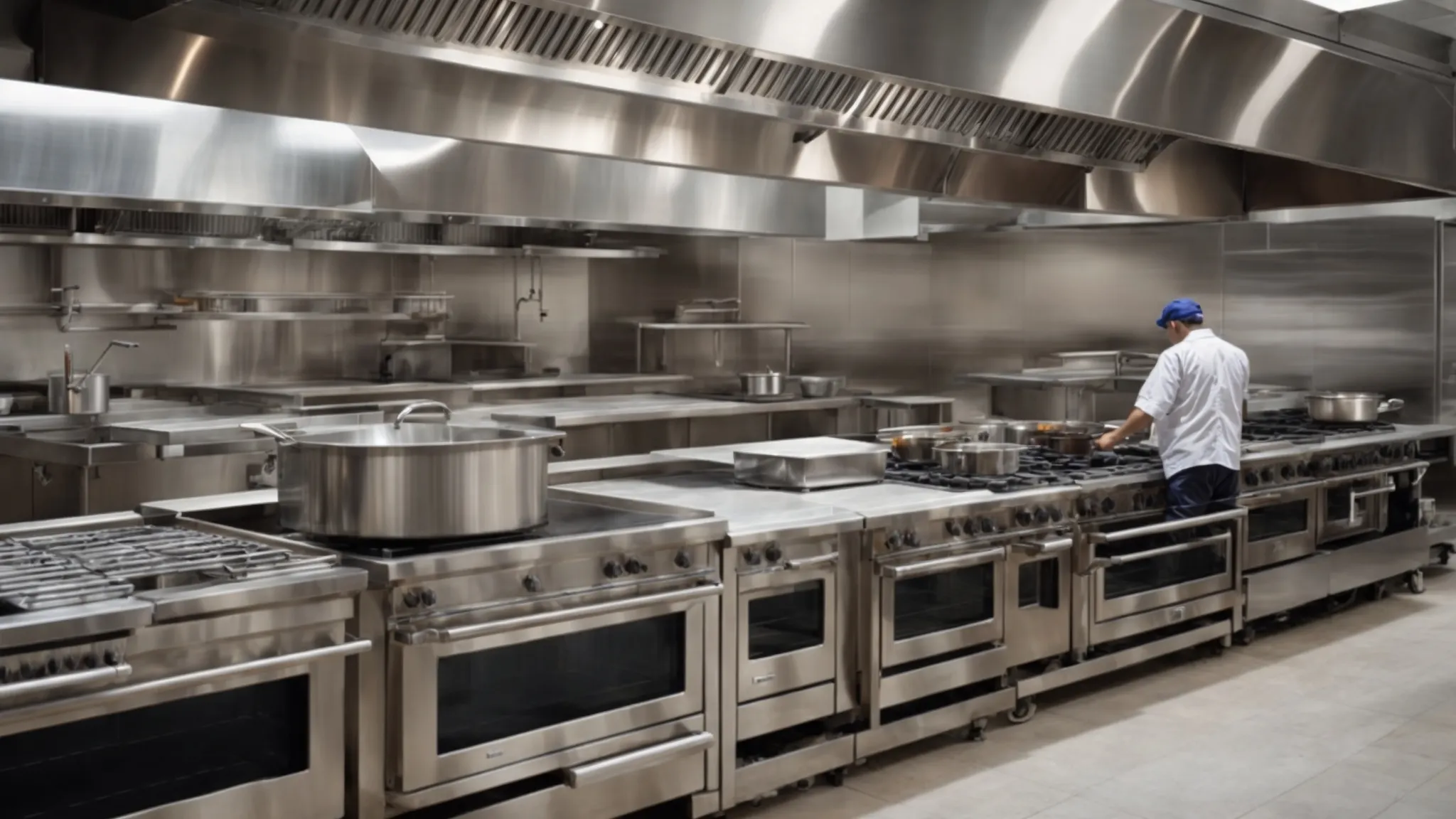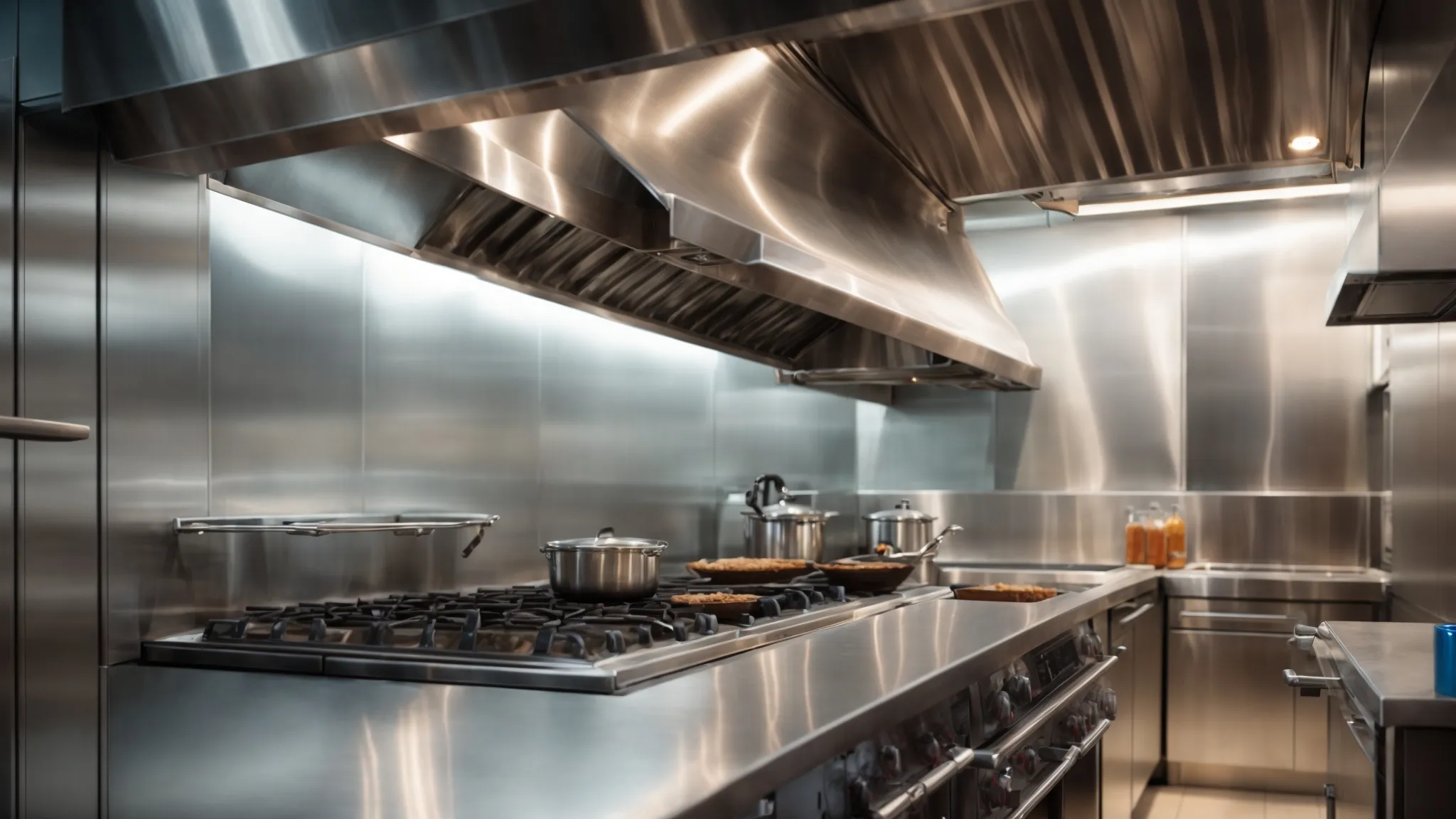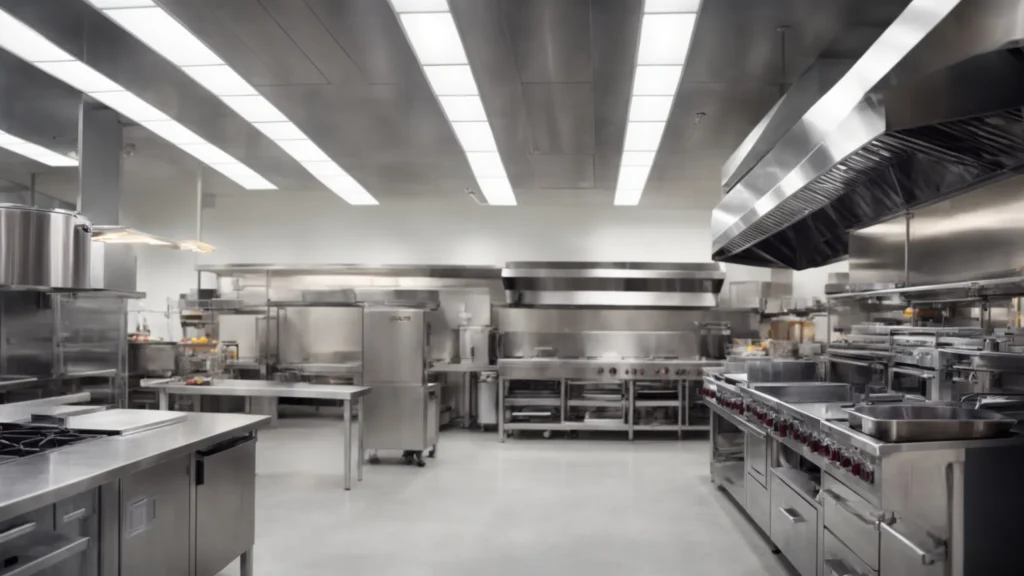Ensure Peak Performance: Routine Hood & Kitchen Exhaust Care
Amid the bustling rhythm of Ontario’s culinary scenes, from the sizzling pans in Toronto to the aromatic bakeries in Brampton, a silent guardian stands watch over their success – the kitchen hood and exhaust system.
Like a vigilant sentinel, it battles against grease, smoke, and odor, ensuring that kitchens operate with efficiency and safety.
Yet, this unsung hero often goes unnoticed until problems arise, leading to potential hazards and disruptions in the culinary workflow.
Therefore, understanding the pivotal role of routine hood and kitchen exhaust care becomes not just a matter of cleanliness but a cornerstone of peak performance in any commercial kitchen setting.
In this enlightening journey, we delve into the why and how of maintaining these vital components, ensuring your kitchen continues to function like a well-oiled machine.
Maintaining your Restaurant’s Efficiency with Regular Hood and Kitchen Exhaust Cleaning
Key Takeaways
- Regular Maintenance of Hood and Kitchen Exhaust Systems Is Crucial for the Efficiency and Safety of Commercial Kitchens
- Identifying and Addressing Signs of Wear, Such as Decreased Airflow and Persistent Odors, Can Prevent Serious Safety Hazards
- Professional Cleaning Services Offer Expertise and Equipment That Might Be Beyond the Reach of Regular Staff, Ensuring Compliance With Health and Safety Standards
- DIY Maintenance Strategies Can Supplement Professional Cleaning but Require Careful Selection of Environmentally Friendly Cleaning Agents and Tools
- Adopting Automated Cleaning Systems Can Increase Maintenance Efficiency, Reduce Labor Costs, and Enhance Kitchen Safety
Understanding the Importance of Regular Hood Maintenance

Like a watchful guardian, regular hood and kitchen exhaust maintenance stands as the linchpin of a smoothly operating commercial kitchen.
It whispers of potential issues through signs often subtle yet critical, holding the sway to ensure peak performance or plunge the kitchen into challenges.
Diving into the heart of this maintenance, identifying signs that demand attention becomes crucial, lest one flirts with the dire consequences of neglect.
With each kitchen serenade, from the bustling din of Toronto’s culinary scenes to the rhythmic sizzle in Calgary’s food trucks, the integrity of the exhaust system shapes the melody of healthy, efficient operations.
As we unravel the tapestry of this maintenance journey, the narrative unfolds, spotlighting the importance of vigilant care in averting the shadows of system failure and ensuring the continuum of culinary excellence.
Identifying Signs That Your Hood Needs Care
Surrounded by the sizzling symphonies of cooking, a kitchen’s hood and exhaust system often silently accrue signs of wear and tear, whispering the need for urgent care through a tapestry of grease and odor. When the luster of a restaurant’s ventilation begins to dim, marked by a decrease in the airflow’s vigor or an unwelcome aroma permeating the culinary stage, it signals the exhaust’s plea for attention, a call to arms against the invisible foes of dirt and bacteria.
Within the bustling heart of establishments from Vancouver’s vibrant eateries to Brampton’s bustling banquet halls, the subtle yet poignant appearance of smoke not swiftly whisked away or grease painting its mark upon surfaces unnoticed stands as a herald. These visual and olfactory cues serve as the clarion call for expertise, urging the restoration of pristine conditions through rigorous hood and exhaust care, to fortify these culinary bastions against the smog of pollution and the simmering threat of fire.
The Consequences of Neglecting Exhaust System Upkeep
Neglecting the upkeep of a kitchen’s exhaust system plants the seeds for a forest of issues, where the unchecked proliferation of grease and debris fans the flames of risk. Such neglect is like inviting an invisible arsonist into the heart of the kitchen, where the buildup of flammable residues waits for a single spark to ignite, threatening not just the rhythm of daily operations but, more gravely, the safety of all within its walls.
Moreover, overlooking regular maintenance throttles the lifeline of indoor air quality, allowing the kitchen to become a stage where the performance is marred by pollutants. This oversight turns the kitchen’s once vibrant symphony into a muffled dirge, compromising the health of staff and patrons alike as it escorts unseen bacteria and odors to stand center stage, challenging the establishment’s reputation and its dedication to hygiene.
Now that the cornerstone of routine hood upkeep has been laid, let’s embark on an exhilarating journey. With sleeves rolled up, we plunge into the nitty-gritty of sparkling kitchen hoods, step by step.
Step-by-Step Guide for Cleaning Kitchen Hoods

Embarking on the journey of hood and kitchen exhaust maintenance is akin to preparing a feast, where having the right ingredients makes all the difference.
The prelude to ensuring this culinary stronghold remains a beacon of efficiency and safety begins with assembling an armory of essential cleaning supplies and tools.
Prior to igniting the process, clothing oneself in the armor of safety measures cannot be overstated; for in this realm, protection from the unforeseen spills and splashes of degreasing dramas is paramount.
This guide will navigate through the meticulous steps, from preparation to execution, ensuring that your kitchen’s vent hood not only meets but exceeds the standards of cleanliness and safety.
Gather Essential Cleaning Supplies and Tools
Before the alchemy of exhaust cleaning begins, securing the right ensemble of cleaning supplies and tools is imperative. This collection acts as the backbone of efficiency, ranging from industrial-strength degreasers to specialized brushes and sponges, each item promising to tackle the grime and grease that cloak a kitchen’s exhaust system. Among these essentials, a powerful yet environmentally friendly detergent stands ready to break the bonds of oil and soot without harming the planet.
Equally vital in this prelude to purity is the acquisition of heavy-duty protective gear. No warrior enters the battle unarmored, and thus, gloves, goggles, and aprons form the crucial defense against the inevitable skirmishes with grease, water, and chemical agents. This preparation ensures that the person tasked with this important job remains unscathed, focusing solely on the restoration of cleanliness and safety to the kitchen’s venting system.
Follow Safety Measures Before Starting the Process
Before the first brush kisses the surface of a greased-stained exhaust, ensuring the safety of all involved marks the beginning of a responsible maintenance regimen. Donning protective gear – gloves, goggles, and aprons – shields the skin and eyes from harsh chemicals and unexpected splashes, encapsulating the bearer in a cocoon of safety as they embark on this vital task.
Securing the area stands as a paramount procedure, signaling to others the commencement of a meticulous cleaning operation. By cordoning off the vicinity with visible signs or barriers, unwitting passersby are deterred from accidentally breaching this temporary, yet necessary, no-man’s-land, thereby ensuring that the mission of restoration proceeds without the threat of injury to the unguarded.
Armed with the essentials of Hood Cleaning, we venture further. Let’s dissect the realms of professional versus DIY cleaning tactics, ensuring your kitchen’s heart beats strong.
Professional vs. DIY Maintenance Strategies Explored

The debate between Professional vs. DIY Maintenance Strategies delves into a pivotal chapter in the saga of sustaining kitchen hygiene and efficiency.
Within this realm, discerning the junctures for summoning the expertise of professional services for a comprehensive deep clean becomes essential, akin to calling forth seasoned warriors when the battle against grime and grease looms large.
Conversely, the art of routine hood maintenance, when wielded skillfully by the kitchen’s own stewards, can significantly uphold the bastion of cleanliness through safe DIY methods.
This narrative explores the harmonious balance between these two strategies, guiding the custodians of commercial kitchens on when to extend the baton to professional hands and how to adeptly manage day-to-day cleaning, ensuring the perpetual triumph of hygiene and safety within their culinary domains.
When to Call in Professionals for a Deep Clean
In the chessboard of kitchen maintenance, there comes a moment when the king — a deep clean service — needs to make its decisive move. Such a critical juncture is heralded when the buildup of grease and debris transcends the scope of routine cleaning, a scenario often underscored by the gradual decline in kitchen ventilation efficiency or the emergence of persistent, unwanted odors. It’s here, amid these signs, that calling upon the mastery of professionals from esteemed services like Toronto Hood Cleaning becomes inevitable, ensuring the restoration of culinary sanctuaries to their zenith of cleanliness and safety.
Moreover, the intricate dance of disassembling, cleaning, and reassembling the components of a kitchen exhaust system often involves tools and techniques beyond the reach of a layperson. When the health of the system is compromised to the point where it threatens not only the airflow but also the establishment’s compliance with stringent health and safety regulations, such as those outlined by NFPA and local fire codes, the wisdom of engaging with specialized companies crystallizes. These expert entities, equipped with industrial-grade equipment and an arsenal of effective, environmentally friendly cleaning solutions, navigate the complexities of comprehensive exhaust care, delivering results that promise not only a higher standard of hygiene but also peace of mind.
Safe DIY Methods for Routine Hood Cleaning
Embarking on the path of DIY kitchen hood cleaning requires a diligent approach, where the wielder of the cloth dances gracefully with the grease. Equipping oneself with a mixture of warm water and an environmentally friendly detergent, the task begins with the gentle yet firm application onto the grimy surfaces. This solution, acting like a potion in the hands of a skilled alchemist, dissolves the bond between the accumulated grease and the metal, preparing the stage for a thorough wipe-down.
Following the initial cleanse, a concoction of baking soda and vinegar serves as the next step in this purification ritual. When applied to the stubborn areas, this mixture fizzes into action, lifting the lingering grease and odors as if by magic. The user, now moving with the precision of a seasoned artist, finishes the task with a soft microfiber towel, buffing the surface to a gleaming finish that reflects not only the physical light but the pride of maintenance done right.
Shifting gears, we transition from the debate of professional versus DIY maintenance. Let’s dive into the strategic world of implementing a scheduled maintenance plan, charting a course for sustained brilliance and reliability.
Implementing a Scheduled Maintenance Plan

Embarking on the quest for culinary perfection necessitates more than just a passion for cooking; it demands an unyielding commitment to the sanctity of the kitchen’s lifelines – the hood and exhaust system.
Within this sphere, the cornerstone of achieving and sustaining peak performance lies in the meticulous implementation of a scheduled maintenance plan.
Tailoring a custom cleaning schedule attuned to the unique demands of each kitchen, coupled with the diligent maintenance of records and reminders, constructs a robust framework for consistent care.
This proactive approach not only fortifies the kitchen against the encroachment of wear and diminishes efficiency but also enshrines a culture of excellence, ensuring that each meal served is a testament to the highest standards of hygiene and safety.
Creating a Custom Cleaning Schedule Based on Usage
The rhythm and intensity of kitchen operations dictate the tempo for exhaust and hood maintenance schedules. For bustling establishments like downtown Toronto eateries that face constant waves of patrons, the demand on the kitchen’s ventilation system skyrockets, necessitating a more frequent dive into deep cleaning to maintain optimal performance and ensure health standards are met.
Conversely, a quaint café in Vaughan, with its serene flow of customers and lighter culinary demands, may not summon the grease and debris as swiftly. This variance in kitchen usage underscores the necessity for a tailored cleaning schedule, ensuring that each establishment preserves its kitchen’s heartbeats without the overreach of maintenance overkill or the peril of neglect.
Keeping Records and Reminders for Consistent Care
In the orchestra of kitchen maintenance, meticulous records and timely reminders serve as the conductors, ensuring every section plays in perfect harmony. These documents, a testament to the diligence of the maintenance crew, chart the history of each cleaning session: a narrative of triumphs over grease and grime.
| Date | Service Performed | Technician | Observations | Next Scheduled Service |
|---|---|---|---|---|
| 2023-05-01 | Full Kitchen Exhaust Cleaning | Jordan Lee | No major issues noted; system operates within normal parameters. | 2023-08-01 |
| 2023-02-01 | Hood and Filter Maintenance | Alex Kim | Replaced worn-out filters, significant grease buildup cleared. | 2023-05-01 |
By creating a cycle of reminders that align with these records, establishments can preempt any potential downtimes, positioning themselves ahead of any complications. This strategic approach mitigates the risk of unexpected system failures, laying a foundation of unwavering reliability and sustained excellence in kitchen operations.
As we master the art of routine upkeep, a new chapter unfolds. Welcome to the realm of cutting-edge tools and products, where exhaust care meets innovation.
Innovative Tools and Products for Efficient Exhaust Care

In the relentless pursuit of culinary excellence, the advent of cutting-edge tools and products promises to elevate kitchen exhaust care to new heights.
Embracing these innovations, from top-rated kitchen hood cleaning agents that meticulously battle against grease and grime, to automated cleaning systems that redefine efficiency, marks a pivotal chapter in the saga of kitchen maintenance.
This section casts a spotlight on these instrumental resources, exploring their tangible benefits and ushering in an era of unparalleled cleanliness and safety for commercial kitchens across the spectrum.
Reviews of Top-Rated Kitchen Hood Cleaning Agents
In the quest for maintaining a gleaming commercial kitchen, the role of kitchen hood cleaning agents cannot be overstated. Leading the charge in this pivotal endeavor are products that have not only proven their mettle in cutting through the toughest grease but also in ensuring user safety and environmental friendliness. Among these champions, a select few have risen to prominence, lauded for their unparalleled ability to restore the luster of exhaust systems with meticulous precision.
Such esteemed agents are characterized by their potent formulations, which are designed to tackle the stubborn residues that cling to kitchen hoods and exhausts, without necessitating harsh scrubbing that could damage delicate surfaces. They exemplify innovation, offering a balance of efficiency and suitability for a range of materials, including stainless steel and aluminum, ensuring that every kitchen can benefit from their application while upholding the highest standards of hygiene and safety.
Exploring the Benefits of Automated Cleaning Systems
In the arena of kitchen maintenance, automated cleaning systems herald a new dawn of efficiency and precision. These systems, leveraging advanced technologies, promise to transform the routine of exhaust care from a labor-intensive task to a seamless, automated operation, enhancing both safety and cleanliness.
| Automated System | Feature | Benefit to Kitchen Operations |
|---|---|---|
| Robotic Hood Cleaners | Precision Cleaning | Reduces labor costs and increases safety by minimizing human intervention. |
| Programmable Spray Systems | Customizable Cleaning Cycles | Ensures consistent cleanliness across all areas of the exhaust system, adapting to specific kitchen needs. |
Embracing such state-of-the-art solutions streamlines the essential chore of exhaust maintenance, allowing restaurant owners and managers to allocate their human resources more effectively. The adoption of automated cleaning systems: a testament to a kitchen’s commitment to sustaining high standards of hygiene and efficiency, ultimately contributing to the longevity of the exhaust infrastructure and indoor air quality.
Exploring the arsenal of innovative tools has set the stage. Let’s delve into the realm of troubleshooting common kitchen exhaust issues, where solutions bring clarity to the cloudiest situations.
Troubleshooting Common Problems With Kitchen Exhausts

Ensuring the efficient operation of a commercial kitchen extends beyond the surface, diving deep into the labyrinth of its exhaust system where hidden adversaries like impeded airflow and noise, along with relentless grease accumulation, lurk.
Tackling these challenges begins with a keen eye and skilled diagnostics, pinpointing disruptions in ventilation flow or abnormal auditory signals that foretell deeper malfunctions.
Equally critical is adopting a strategic approach to combating grease buildup, a task that demands precision, persistence, and the correct amalgam of tools and techniques.
This segment elucidates the pathway to identifying and rectifying these common yet impactful issues, thereby safeguarding the kitchen’s pulse and maintaining its harmony.
Diagnosing Issues With Ventilation Flow or Noise
Unraveling the challenges of a kitchen exhaust begins by attuning one’s senses to the subtle deviations in ventilation flow or the dissonance of noise, often the harbingers of underlying issues. A decrease in airflow efficiency signals a congestion within the ducts or filters, while an increase in operational sound may indicate an obstruction or malfunction in the centrifugal fan, each symptom demanding immediate investigation.
Addressing these prophetic signs with precision involves a meticulous inspection of the exhaust system, from the hood to the chimney, identifying any disruptions in the delicate balance of air movement. Professionals adept in hood and exhaust care employ diagnostic tools and techniques to pinpoint the source of the inefficiency, ensuring the restoration of optimal kitchen ventilation and tranquility to the culinary theatre.
How to Address Grease Buildup Effectively
Addressing grease buildup is akin to navigating a labyrinth; it’s crucial to have a map and the right tools. Utilizing a combination of high-strength degreasers and specialized equipment effectively cuts through the layers of accumulated grease, restoring the kitchen exhaust system to its optimal condition. The process involves applying a potent degreasing solution that seamlessly dissolves grease, followed by thorough scrubbing with brushes designed to reach every nook and cranny without damaging the system’s integrity.
| Step | Action | Expected Outcome |
|---|---|---|
| 1 | Apply Degreasing Solution | Grease begins to dissolve, making it easier to remove. |
| 2 | Scrub with Specialized Brushes | Residual grease is completely eradicated, leaving surfaces clean. |
In conjunction with mechanical cleaning, employing hot water pressure washing ensures no traces of grease are left behind: a strategy that comprehensively addresses grease buildup. This step involves blasting all surfaces with hot water under high pressure, which not only removes the loosened grease but also significantly reduces the presence of bacteria and other contaminants. The result is a pristine exhaust system, functioning at peak efficiency and significantly reducing the risk of fire hazards.

